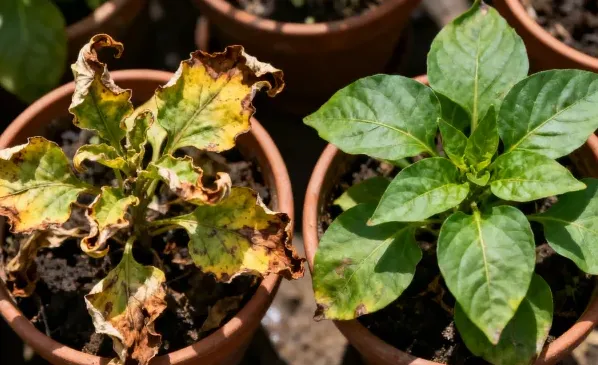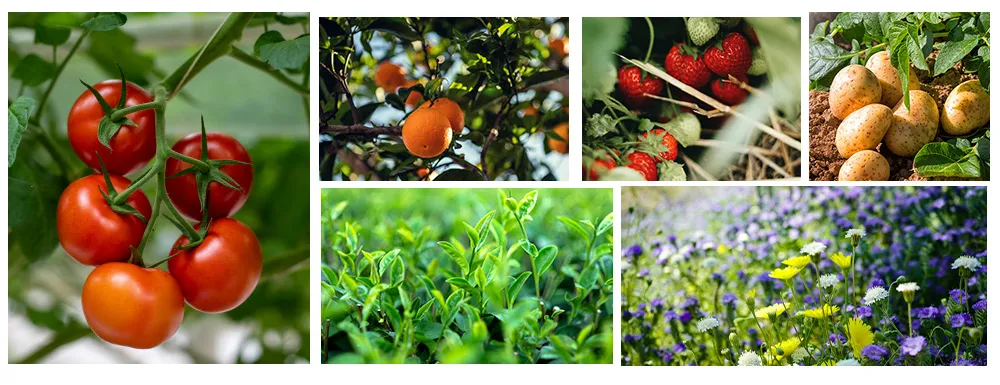Avoid your inquiry is delay response, please enter your WhatsApp/Skype along with the message, so we can contact you at the very first time.
We will reply you within 24 hours. If for urgent case, please add WhatsApp/WeChat:
Warning: Undefined variable $public in /www/wwwroot/lvfertilizer.com/wp-content/themes/hyhadmin/header.php on line 350
Warning: Trying to access array offset on value of type null in /www/wwwroot/lvfertilizer.com/wp-content/themes/hyhadmin/header.php on line 350
,. Or call
Warning: Undefined variable $public in /www/wwwroot/lvfertilizer.com/wp-content/themes/hyhadmin/header.php on line 350
Warning: Trying to access array offset on value of type null in /www/wwwroot/lvfertilizer.com/wp-content/themes/hyhadmin/header.php on line 350
directly.
Are your plants looking weak? Do they have yellow leaf edges or poor fruit development? Your garden might be crying out for potassium. But knowing when to use high potassium fertilizer can make the difference between thriving plants and wasted money.
In this comprehensive guide, I’ll help you understand exactly when, why, and how to use high potassium fertilizers for maximum benefit, based on scientific evidence and practical experience.
Plants suffering from potassium deficiency show clear warning signs:
Potassium is the third key nutrient of commercial fertilizers. It helps strengthen plants’ abilities to resist disease and plays an important role in increasing crop yields and overall quality. Potassium also protects the plant when the weather is cold or dry, strengthening its root systems.
If you’ve noticed these symptoms, simply adding more general fertilizer won’t fix the problem. You need a targeted approach with the right high-K fertilizer at the right time.
Potassium (K) is an essential nutrient for plant growth. It’s classified as a macronutrient because plants take up large quantities of K during their life cycle. Minnesota soils can supply some K for crop production, but when the supply from the soil isn’t adequate, a fertilizer program must supply the K.
Potassium is one of the 17 essential nutrients required by plants for growth and reproduction. Potassium is vital to consistently improve crop productivity.
Unlike nitrogen, which promotes leafy green growth, potassium plays several critical but less visible roles:
Potassium is associated with the movement of water, nutrients and carbohydrates in plant tissue. It’s involved with enzyme activation within the plant, which affects protein, starch and adenosine triphosphate (ATP) production. The production of ATP can regulate the rate of photosynthesis.
Potassium helps flowers and fruit to form and also toughens growth in order to resist pests and diseases. It also helps increase resistance to drought or extreme cold. Potassium deficiency is more common on light, sandy soils and signs include brown scorching and curling of leaf tips.

Adding high potassium fertilizer at the right time maximizes its benefits. Here are the key times to apply:
Potassium-rich fertilizers help newly transplanted plants get established quickly. Since potassium plays such a crucial role in the flowering and fruiting processes, it’s best to apply high-potassium fertilizers in spring, at the start of the growing season.
For fruiting plants like tomatoes, the critical moment comes just before flowering:
The heavy consumption of potassium actually starts about 2 weeks before the first flowers are visible. The concept of ‘banking’ potassium or applying extra a bit earlier seems to be in order to reduce packing house losses.
Giving plants an extra dose of potassium when they need it most allows them to produce the best quality flowers and fruits possible. However, you can also apply high-potassium fertilizers in midsummer to help protect your plants from dry spells and extreme temperatures.
High-potassium fertilizers are also an appropriate choice for feeding plants in autumn, just before they go dormant over the winter. Potassium helps plants survive cold weather just as well as hot.
Increase watering to prevent salt buildup in container and field applications. Fall is often overlooked, but it’s a critical window for root regeneration, carbohydrate storage, and nutrient replenishment after the active growing season. Trees and perennials benefit from potassium-rich options such as Ugarit Multi to enhance winter hardiness.
Potassium’s role in root development makes it a good choice of fertilizer for seedlings that have been newly transplanted.
While all plants need potassium, some crops have especially high requirements or benefit more dramatically from potassium supplementation:
Use potassium fertilizers for plants that produce flowers and fruit. This mineral improves fruit size, appearance, color, acidity, taste, and vitamin content by activating enzymes that produce proteins and sugars. Tomatoes require high levels of potassium to produce lycopene.
Growing great tomatoes that are full-flavored and have low losses in the packing house requires keeping tissue potassium levels above 3%. From before the first blossoms to the last harvest, tomato plants (and peppers as well) require huge amounts of potassium to produce the most flavor and prevent yellow shoulders/gray wall.
Any deficiency of potassium will affect the harvest quality of fruits and tubers. Plants with large flowers like the lipstick plant, roses, hibiscus, African violets, and orchids, will also need lots of potassium just before and during their flowering period. For that phase, a nitrogen-to-potassium ratio of 1:2 is recommended.
All plants require potassium, and using a high-potassium fertilizer is an excellent method to correct deficiencies in the soil, especially after intensive agricultural practices. Higher volumes of potassium improve root, flower, and fruit development and all other functions in a plant.

Follow these general guidelines for application rates (but always check your specific product’s instructions):
| Plant Type | Application Rate | Frequency |
| Flowering & Fruiting Plants | 1-2 tbsp per gallon of water or as directed | Every 2-4 weeks |
| General Plant Health | 1 tbsp per gallon of water | Every 6-8 weeks |
| Container Plants | 1/2 strength of recommended dose | Monthly |
| Established Trees/Shrubs | 1/2 cup per inch of trunk diameter | Spring and Fall |
For flowering & fruiting plants: Apply every 2-4 weeks. For general plant health: Apply every 6-8 weeks. Avoid excessive application to prevent potassium buildup.
Many options exist for applying potassium to your plants:
Sources include: Banana peels – A rich, slow-release source of potassium. Wood ash – Provides potassium but should be used sparingly. Composted fruit & vegetable scraps – Gradually releases potassium into the soil. Seaweed or kelp meal – High in potassium and micronutrients.
Look for fertilizers with a high third number in the NPK ratio (the K number). Excellent options include:
Organic fertilizers often have a wide range of nutrients. For example kelp meal contains potassium but also many trace minerals. An organic fertilizer feeds beneficial soil microbes, which boost plant health. A conventional fertilizer does not.
Many organic materials provide potassium:
The heavy consumption of potassium actually starts about 2 weeks before the first flowers are visible. The concept of ‘banking’ potassium or applying extra a bit earlier seems to be in order to reduce packing house losses. Since we need to start the application of higher levels of potassium earlier than flowering in order to bank some and have high enough levels for the first fruit, tissue analysis should start as soon as your plants are large enough to collect full sized mature leaves from and not cripple your plants. Make the change to a higher potassium ratio fertilizer about 2 weeks prior to what you’ve been doing in the past and start a weekly foliar application of potassium at the same time.

Trees and perennials benefit from potassium-rich options such as Ugarit Multi to enhance winter hardiness. Use SULPHOMIN (45% N, 15% SO3) for nitrogen release into cool-season lawns and leafy greens. Avoid excessive nitrogen in late fall to reduce frost damage risk. Apply 6-8 weeks before the first expected frost date for optimal uptake.
Before applying any high potassium fertilizer, it’s essential to know your soil’s current nutrient status:
For example, sandy soils in high rainfall areas often lack in potassium. If you’re ever unsure about what nutrients your plants need, conducting a soil test analysis is the safest bet to ensure you accurately provide the nutrients your plants require at any given time.
You can monitor K status of soils with plant analysis and routine soil testing. Soil testing is the most reliable predictor of a fertilizer program’s need for potash.
Sometimes what looks like potassium deficiency may be caused by other factors:
Potassium (K) deficiency symptoms occur when plants cannot extract K from the surface soil. Any soil or weather factor that stresses or limits root growth, such as soil-test K stratification, compacted soil, root pruning, dry and loose soil, seed furrow sidewall compaction, can limit plant K uptake. As growth continues during the season, K uptake may be increased or remain reduced depending on the subsoil K supply and moisture content. Plant pathogens and herbicide damage sometimes affect corn or soybean plants and can induce leaf K deficiency symptoms even in high-testing soils.
To ensure you’re addressing the right problem:
Adding too much of any single nutrient can create imbalances. Be aware of these interactions:
To maximize the response potassium fertilizer has on crops, other nutrients are needed. High-potassium fertilization can decrease the availability of magnesium to the plant and may cause a magnesium deficiency if the soil is already low in magnesium. It also works the other way. Crops grown in soils with high magnesium can suffer potassium deficiency. Ultimately, it’s important to consider all factors and nutrients when crop planning. Nutrient balance is needed to get the most out of potassium fertilizer application, as well as fertilizing of any kind.
As a professional fertilizer manufacturer with over 25 years of experience, Shandong Lvfeng Fertilizer Co., Ltd. produces high-quality potassium fertilizers that provide excellent results for different plant needs.
Our range includes:
Our potassium fertilizers are produced in state-of-the-art facilities with rigorous quality control to ensure consistent performance.
High potassium fertilizers can dramatically improve plant health, fruit and flower production, and stress tolerance when used correctly. Remember these key points:
By understanding when to use high potassium fertilizer, you’ll maximize its benefits and avoid waste, resulting in healthier plants, better harvests, and a more beautiful garden.
Do you have questions about potassium fertilizer for your specific plants or situation? Let us know in the comments below!
| Application Type | Rate | Frequency |
|---|---|---|
| Garden (0-0-60) | 100-150g/25 sq ft | Every 4-6 weeks |
| Foliar Spray | 1 tsp/gal water | Every 2 weeks |
| Sandy Soils | 75-100g/25 sq ft | Every 3 weeks |
⚠️ Soil testing is required before application
⚠️ Sandy soils need 50% more frequent applications
40-50%
More blooms in roses with optimal K timing
50-70%
Potassium loss through leaching in sandy soils
2-3 Weeks
Before blossom visibility for best results